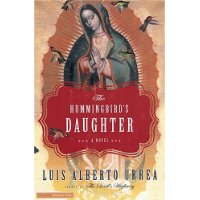| 商家名称 |
信用等级 |
购买信息 |
订购本书 |
|
|
 |
The Hummingbird's Daughter |
 |
|
 |
The Hummingbird's Daughter |
 |

基本信息·出版社:Back Bay Books
·页码:512 页
·出版日期:2006年09月
·ISBN:0316013811
·条形码:9780316013819
·装帧:平装
·开本:32开 Pages Per Sheet
·外文书名:蜂鸟的女儿
内容简介 在线阅读本书
The prizewinning writer Luis Alberto Urrea's long-awaited novel is an epic mystical drama of a young woman's sudden sainthood in late 19th-century Mexico.
--This text refers to the Hardcover edition. 作者简介 Luis Alberto Urrea is the recipient of a Lannan Literary Award, an American Book Award, a Western States Book Award, and a Colorado Book Award, and has been inducted into the Latino Literary Hall of Fame. He lives in Chicago.
--This text refers to the Paperback edition. 媒体推荐 书评
From Publishers Weekly Starred Review. "Her powers were growing now, like her body. No one knew where the strange things came from. Some said they sprang up in her after the desert sojourn with Huila. Some said they came from somewhere else, some deep inner landscape no one could touch. That they had been there all along." Teresita, the real-life "Saint of Cabora," was born in 1873 to a 14-year-old Indian girl impregnated by a prosperous rancher near the Mexico-Arizona border. Raised in dire poverty by an abusive aunt, the little girl still learned music and horsemanship and even to read: she was a "chosen child," showing such remarkable healing powers that the ranch''s medicine woman took her as an apprentice, and the rancher, Don Tomás Urrea, took her—barefoot and dirty—into his own household. At 16, Teresita was raped, lapsed into a coma and apparently died. At her wake, though, she sat up in her coffin and declared that it was not for her. Pilgrims came to her by the thousands, even as the Catholic Church denounced her as a heretic; she was also accused of fomenting an Indian uprising against Mexico and, at 19, sentenced to be shot. From this already tumultuous tale of his great-aunt Teresa, American Book Award–winner Urrea (
The Devil''s Highway) fashions an astonishing novel set against the guerrilla violence of post–Civil War southwestern border disputes and incipient revolution. His brilliant prose is saturated with the cadences and insights of Latin-American magical realism and tempered by his exacting reporter''s eye and extensive historical investigation. The book is wildly romantic, sweeping in its effect, employing the techniques of Catholic hagiography, Western fairy tale, Indian legend and everyday family folklore against the gritty historical realities of war, poverty, prejudice, lawlessness, torture and genocide. Urrea effortlessly links Teresita''s supernatural calling to the turmoil of the times, concealing substantial intellectual content behind effervescent storytelling and considerable humor.
Copyright © Reed Business Information, a division of Reed Elsevier Inc. All rights reserved.
--This text refers to the Hardcover edition. From The New Yorker Twenty years in the making, Urrea''s epic novel recounts the true story of his great-aunt Teresita. In 1873, amid the political turbulence of General Porfirio Díaz''s Mexican republic, Teresita is born to a fourteen-year-old Indian girl, "mounted and forgotten" by her white master. Don Tomàs Urrea later takes his illegitimate daughter into his home, where she learns to bathe every week and read "Las Hermanas Brontë." But Teresita also continues a folk education as a curandera, discovering healing powers and a mystical relationship with God. Indian pilgrims swarm to the Urrea ranch, where "St. Teresita," a mestiza Joan of Arc, kindles in them a powerful faith in God and a perilous hunger for revolution. The novel brings to life not only the deeply pious figure whom Díaz himself dubbed "the Most Dangerous Girl in Mexico" but also the blood-soaked landscape of pre-revolutionary Mexico.
Copyright © 2005
The New Yorker --This text refers to the Hardcover edition. From Bookmarks Magazine Everyone raves about the grand, exquisitely detailed storytelling of the first-time novelist, though Urrea has written 10 previous books of nonfiction (see
The Devil’s Highway, HHHH July/Aug 2004).
The Hummingbird’s Daughter is a history lesson that follows the brewing rebellion in 1889 against a longtime Mexican dictator. Urrea meticulously captures day-to-day life among the poor farmers and their populist beliefs in their saint. Of course there’s also humor, heartbreak, torture, and perhaps a few too many descriptions. To sum up, we’ll leave it to
The New York Times: "These 500 pages—though they could have been fewer—slip past effortlessly."
Copyright © 2004 Phillips & Nelson Media, Inc. --This text refers to the Hardcover edition.




